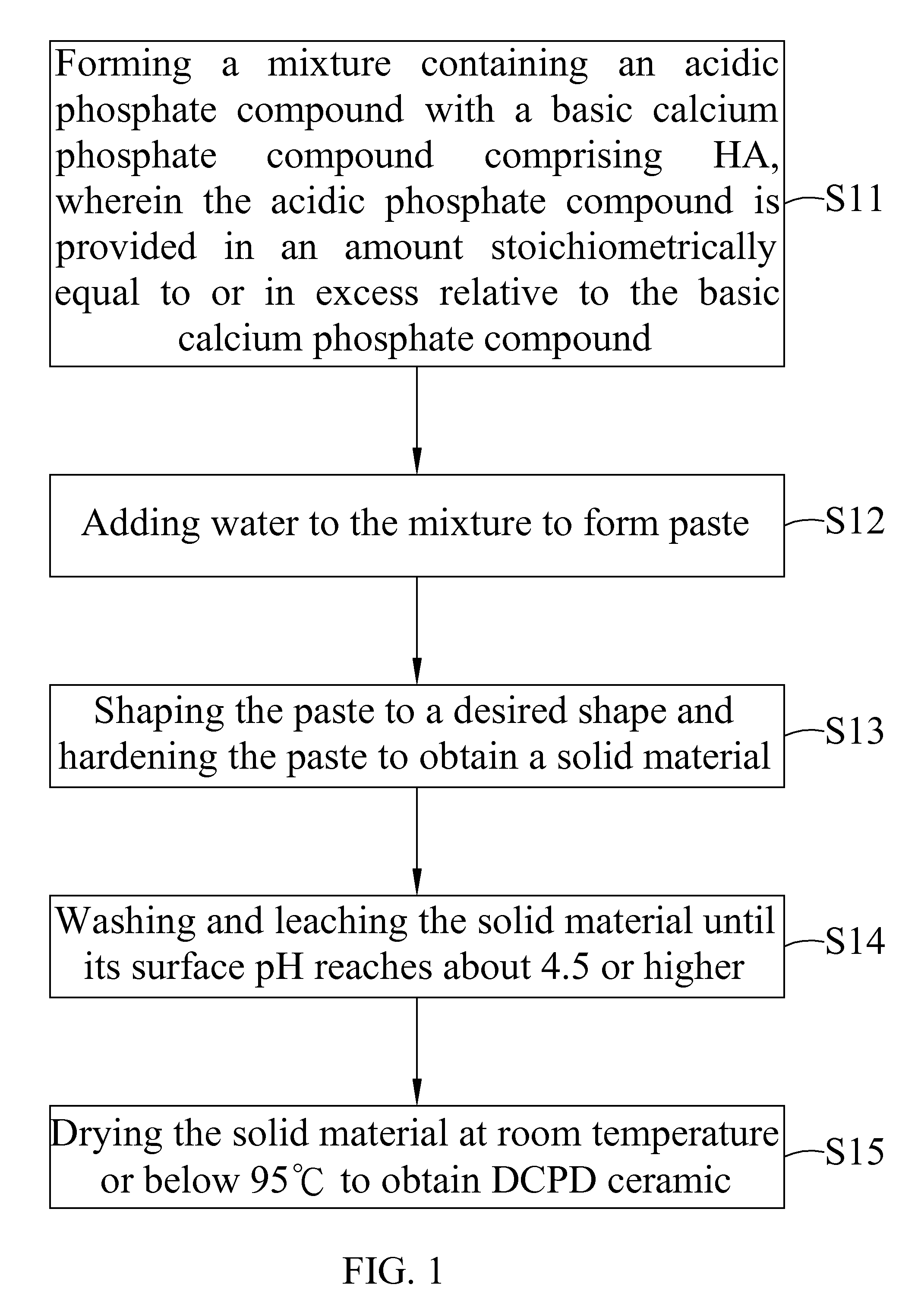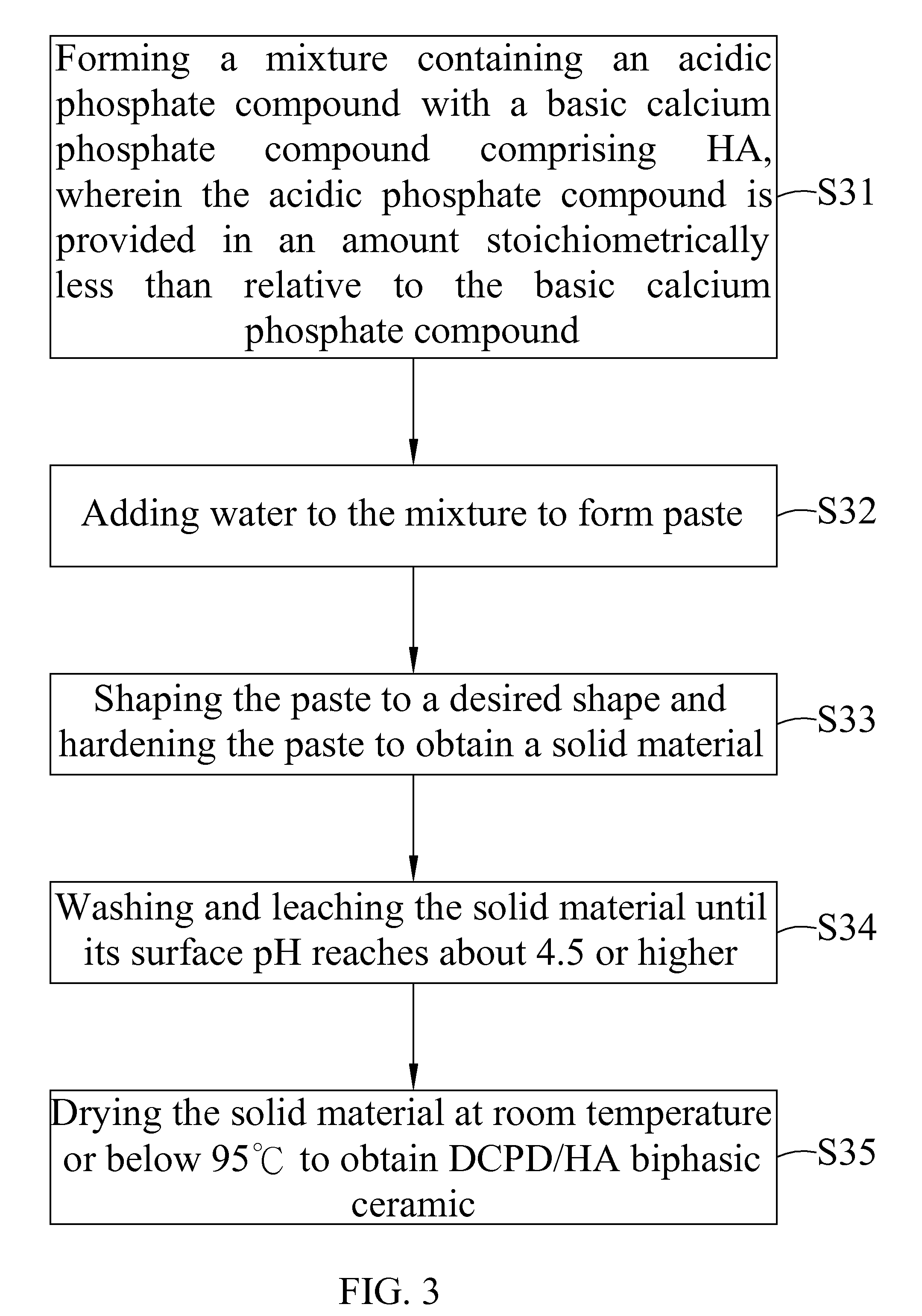Dicalcium phosphate ceramics, dicalcium phosphate/hydroxyapatite biphasic ceramics and method of manufacturing the same
a technology of dicalcium phosphate and ceramics, which is applied in the field of manufacturing methods of new bioresorbable calcium phosphate ceramics, can solve the problems of affecting the use of precipitated ha as useful hard tissue replacement materials, affecting the resorption rate of above ceramics, and affecting the resorption rate of other precipitated calcium phosphate particles, etc., to achieve excellent biocompatibility and controllable bioresorption rates, useful in orthopedic and maxillofacial surgeries
- Summary
- Abstract
- Description
- Claims
- Application Information
AI Technical Summary
Benefits of technology
Problems solved by technology
Method used
Image
Examples
example 1
[0045]6 g of sintered HA (particle size smaller than 105 μm) was mixed with 8 g of Ca(H2PO4)2.H2O. This mixture was added with enough pure water to form paste. The paste was shaped to form a block and set at about 30 minutes to obtain a solid material. The solid material was leached with 50 ml of water each time. The leaching process was repeated until the surface pH of the solid material was about 5.5. The solid material was air dried to obtain a product in block form. X-ray study indicated that the product showed pure dicalcium phosphate dehydrate (DCPD) ceramic. Surface pH of the block product is near neutral. Further, part of the block product was crushed and passed a mesh to collect the granules with a size between 5 mesh and 35 mesh.
[0046]Pure DCPD ceramic in granular or block form was put in oven at temperature 100° C. or slighter higher for overnight to obtain pure dicalcium phosphate anhydrous (DCPA) ceramic.
example 2
[0047]4 g of sintered HA (with particle size smaller than 150 μm) was mixed with 4.5 g of Ca(H2PO4)2 and 3 g of sucrose. The mixture was added with enough water to form paste. The paste was kept in room temperature until it became a hardened solid material. The solid material was repeatedly leached with about 50 ml of pure water each time until the surface pH of the solid material was near 5.5. The final leached solid material was air dried to get a product with a nice macroporous structure. X-ray showed the product is pure DCPD ceramic. Part of pure DCPD ceramic was crushed and sieved to collect DCPD ceramic granules with a particle size between 0.5 mm to about 3 mm.
example 3
[0048]2 g of sintered HA (with a particle size passed through 150 mesh) was mixed with 0.6 g Ca(H2PO4)2.H2O and pasted with 0.7 g of pure water. The paste was shaped in a rectangular form and set at about 25 minutes to harden the paste to obtain a solid material. After setting, the hardened solid material was kept in air for several hours. After that, the solid material was leached and washed several times with pure water. The leaching and washing processes were repeated until the surface pH of the solid material was near 6 or slightly lower. The final leached solid material was air dried to obtain DCPD / HA biphasic ceramic with 2.8 g of weight and 2.52 g / cc of density.
[0049]The DCPD / HA biphasic ceramic was put in oven at temperature 100° C. or slighter higher for overnight to obtain DCPA / HA biphasic ceramic.
PUM
| Property | Measurement | Unit |
|---|---|---|
| temperature | aaaaa | aaaaa |
| temperature | aaaaa | aaaaa |
| temperature | aaaaa | aaaaa |
Abstract
Description
Claims
Application Information
 Login to View More
Login to View More - R&D
- Intellectual Property
- Life Sciences
- Materials
- Tech Scout
- Unparalleled Data Quality
- Higher Quality Content
- 60% Fewer Hallucinations
Browse by: Latest US Patents, China's latest patents, Technical Efficacy Thesaurus, Application Domain, Technology Topic, Popular Technical Reports.
© 2025 PatSnap. All rights reserved.Legal|Privacy policy|Modern Slavery Act Transparency Statement|Sitemap|About US| Contact US: help@patsnap.com



